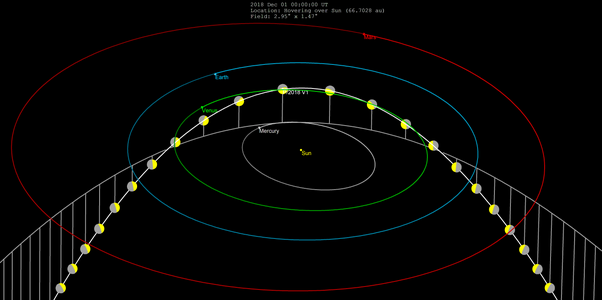C/2018 V1 (Machholz–Fujikawa–Iwamoto) (original) (raw)
From Wikipedia, the free encyclopedia
(Redirected from C/2018 V1)
Comet
C/2018 V1 (Machholz–Fujikawa–Iwamoto)
 Path of comet across sky, with 7-day motion shown Path of comet across sky, with 7-day motion shown |
|
|---|---|
| Discovery | |
| Discovered by | Donald Machholz |
| Discovery date | 7 November 2018 |
| Orbital characteristics[1] | |
| Epoch 16 November 2018 | |
| Observation arc | 37 days |
| Perihelion | 0.386954 AU |
| Eccentricity | 1.00040 |
| Orbital period (sidereal) | ejection(barycentric epoch 2050) |
| Mean anomaly | -0.00057 |
| Inclination | 143.9878° |
| Longitude of ascending node | 128.7222° |
| Argument of perihelion | 88.7749° |
| Earth MOID | 0.115002 AU |
| Physical characteristics | |
| Apparent magnitude | 28.0 |
This article is about the comet with a hyperbolic trajectory. For a different comet that passed by Earth in February 2019, see C/2018 Y1 (Iwamoto).
Comet C/2018 V1 (Machholz–Fujikawa–Iwamoto) is a minor body that follows a slightly hyperbolic orbit (eccentricity > 1, 16.4-sigma). It was visually discovered on 7 November 2018 by Donald Machholz using an 18.5-inch reflecting telescope[2]and it reached perihelion on 3 December 2018.
It was estimated to be between 8 and 10th magnitude from mid-November to mid-December 2018, visible in a small telescope. The value of its total (absolute magnitude of comet and coma) magnitude is 14.6 mag. It was discovered by three amateur astronomers: by an observer in Colfax, California, USA and by two observers in Japan.[3][2] The observations by three astronomers result in the name for the comet, Machholz-Fujikawa-Iwamoto.[2][4] The current orbit determination of this comet is based on 750 observations with a 37-day observation arc.[1]
Comet C/2018 V1 has a significant probability (72.6%) of having an extrasolar provenance although an origin in the Oort Cloud cannot be excluded.[5] As the present-day value of its barycentric orbital eccentricity is greater than 1, this comet is currently escaping from the Solar System, aiming for interstellar space.[5]

Perihelion in early December 2018, above the orbit of Mercury
Animation of C/2018 V1's orbit
Sun ·
Mercury ·
Venus ·
Earth ·
Mars ·
C/2018 V1- List of parabolic comets
- ^ a b "Small-Body Database Lookup".
- ^ a b c Dickinson, David (16 November 2018). "New Comet V1 Machholz-Fujikawa-Iwamoto Takes Observers by Surprise". Universe Today. Retrieved 16 November 2018.
- ^ Phillips, Tony (14 November 2018). "Amateur Astronomers Discover a Bright New Comet". Spaceweather.com. Retrieved 16 November 2018.
- ^ Chambó, José J. (14 November 2018). "New comet C/2018 V1 Machholz-Fujikawa-Iwamoto". Sky & Telescope. Retrieved 16 November 2018.
- ^ a b de la Fuente Marcos, Carlos; de la Fuente Marcos, Raúl (11 October 2019). "Comet C/2018 V1 (Machholz-Fujikawa-Iwamoto): dislodged from the Oort Cloud or coming from interstellar space?". Monthly Notices of the Royal Astronomical Society. 489 (1): 951–961. arXiv:1908.02666. Bibcode:2019MNRAS.489..951D. doi:10.1093/mnras/stz2229.
- MPEC 2018-V151: COMET C/2018 V1 (Machholz-Fujikawa-Iwamoto)
- Amateur Don Machholz Discovers His 12th Comet!, Sky and Telescope, 9 November 2018
- Arizona Amateur Discovers New Dawn Comet — Here’s How To Find It Bob King, 11 November 2018
- Comet C/2018 V1 (Machholz-Fujikawa-Iwamoto) Sky Charts and Coordinates Archived 15 November 2018 at the Wayback Machine
- JPL viewer
- C/2018 V1 at the JPL Small-Body Database